
- Homepage
- Art Movement
- Characteristics
- Boxed, On Canvas (2)
- Framed (29)
- Framed, On Canvas (39)
- Framed, On Panel (7)
- Framed, On Wood (9)
- Framed, Signed (5)
- Oil On Paper (2)
- On Canvas (262)
- On Canvas, Framed (4)
- On Canvas, Signed (5)
- On Panel (43)
- On Panel, On Canvas (16)
- On Wood (15)
- On Wood, On Canvas (2)
- On Wood, On Panel (2)
- One Of A Kind (ooak) (3)
- Signed (16)
- Signed, On Canvas (77)
- Signed, On Panel (16)
- Signed, On Wood (5)
- Other (3695)
- Genre
- Abstract (13)
- Académisme (16)
- Art Deco (15)
- Art Déco (40)
- Barbizon (13)
- Baroque (30)
- Classicism (131)
- Classicisme (191)
- Expressionism (139)
- Expressionnisme (90)
- Fauvism (37)
- Fauvisme (16)
- Impressionism (142)
- Impressionist (12)
- Impressionnisme (202)
- Realism (54)
- Romanticism (33)
- Romantisme (34)
- Réalisme (77)
- Voir Photos (33)
- Other (2936)
- Theme
- Abstract (3)
- Animals (17)
- Animated Landscape. (4)
- Architecture (4)
- Art (4)
- Character (49)
- Child (9)
- Flower, Tree (10)
- Genre Scene (36)
- History, War (6)
- Interior Scene (3)
- Landscape (305)
- Marine (3)
- Nude (3)
- Portrait (9)
- Portrait / Face (5)
- Religion, Mythology (28)
- Sacred Subject (9)
- Seascape, Boat (34)
- Still Life (92)
- Other (3621)
- Thème
- Animals (11)
- Animaux (100)
- Architecture (14)
- Character (18)
- Enfant (35)
- Fleur, Arbre (50)
- Genre Scene (20)
- Histoire, Guerre (17)
- Landscape (106)
- Marine (12)
- Nature Morte (190)
- Paysage (557)
- Personnage (138)
- Portrait (13)
- Religion (11)
- Religion, Mythologie (163)
- Scène De Genre (109)
- Seascape, Boat (15)
- Still Life (19)
- Voir Photos (27)
- Other (2629)
- Type
Small Old Oil Painting from the Barbizon School 19th century Harpignies Rousseau
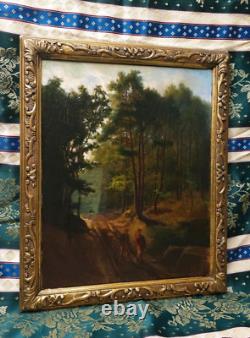
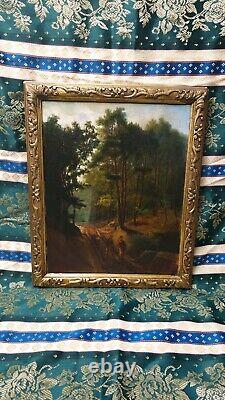
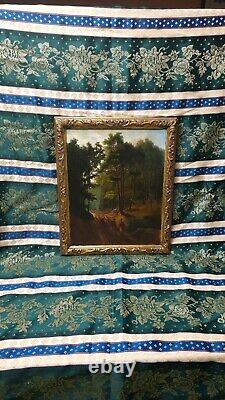
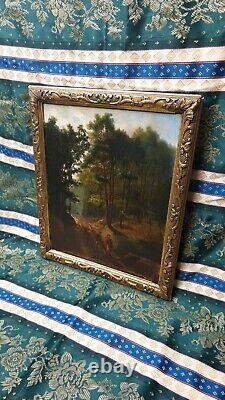


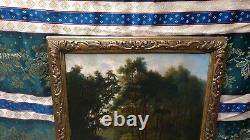
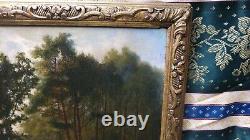



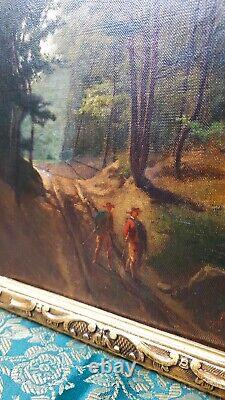
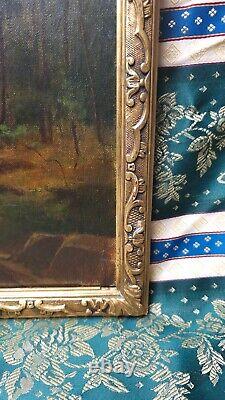
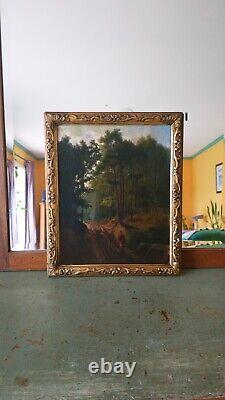


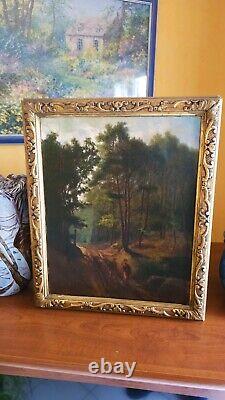

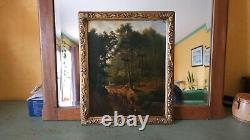
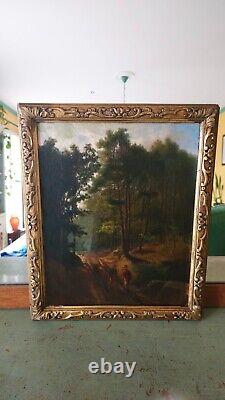


Hello, I am selling this painting with a height of 38 cm by 27 cm wide if we only consider the painted part. It is a superb unsigned oil on canvas, probably created during the second half of the 19th century (possibly a French or Swiss school), depicting the edge of a forest in the early morning, a moment that two walkers have chosen for their stroll.
The light, soft regardless of its shade, the blue tones of the sky, becoming tender as they approach the right edge of the composition, easily immerse us in this wonderful chiaroscuro with tree shadows, sometimes projected on the ground, sometimes in their foliage. A special mention for the superb photorealism of the clouds, both in their shapes and in their shades, underlining, if needed, the truly real and remarkable talent of the artist behind this work. The painting has undergone significant restoration carried out by myself; thus defects that appear in the penultimate photo, all paint losses, some of which were on the verge of creating holes in the canvas, have been repaired to the best of my abilities, not being a professional restorer, which did not prevent me from using materials used by such a person, for example putty, which I applied to the various losses before painting (it protrudes on the back, which explains the particularly solid white clumps in the relevant areas), or a matte varnish, which I chose instead of the old varnish, previously removed because it reflected shine effects that tended to highlight the repairs while I was seeking the most harmonious result possible, and to create reflections here and there causing significant imbalances in the treatment of light in this composition.
Among the most notable actions I have taken. Modification of the light shade appearing in what looked like a clearing, changing it from a yellow-green to a white-green, for a result that I find much more interesting than the original as, beyond constituting a very pleasant hue, it reinforces the power of the chiaroscuro and the perspective of the path, which now leads, furthest from the clearing, to the entrance of a wooded tunnel, highlighted by a dark shade, which can now be related to the new vanishing point of the work. Still with the aim of reinforcing the chiaroscuro, what I wanted to resemble stones whitened by the intensity of the light at that point; the presence of two new shadows projected for two trees just to the right of the clearing, in order to reinforce the beam of light coming from the clearing. There was an unpleasant effect of twigs being camouflaged by a cloud, which I fixed by reproducing a darkened cloud shade; two smaller losses, located on the upper left and right corners, were harmonized as best as possible, the left one, once again, with a darkened cloud shade effect, the right one with a gray-white similar to a cloud. All these improvements and/or repairs integrate particularly well with what was in good condition, and represented no less than 15 hours of work (see the last two photos for a before-after overview).
Naturally, when viewed up close they could not be confused with the original content, as the real interest lies at a distance of two or three meters, which would have been the minimum anyway to fully appreciate the composition. One of these repairs, despite the application of a matte varnish, is less discreet than the others, it is the one on the foliage of a tree, high up, almost below the sky; however, I noticed, and some photos illustrate it, that depending on the light and the viewing angle from which we look at the work, it fades more or less. So, it will be up to you to choose the most suitable location if you want an optimum result. Apart from these elements, the original painting, despite tiny paint losses and tiny holes that have not been filled (and only visible when the painting is backlit by a light source), is in very good condition, with some very fine and shallow cracks in places, very good canvas tension except in a few places corresponding to the clearing floor, a little above, and the foliage of the aforementioned tree (slight tension defects already present originally), and the frame, despite some small stucco losses and gilding wear here and there, still presents very well, and has also benefited from slight touch-ups carried out by myself to conceal the most blatant stucco and gilding losses on the right side (visible changes on the last two photos).
The framed painting has a slight gap between the stretcher and the frame, discreet, and an old trace of a previous frame on the right edge, in some places, so discreet that it barely appears in some photos; as for the trace of this same old frame appearing at the level of the sky (penultimate photo), I managed to remove it. Note on the back a very old label showing that it probably passed through an auction room. The photos were taken under a skylight created by my Velux window, on an afternoon delivering a soft winter light. After numerous tests, I realized that the color rendering in photos 2 to 5, with my equipment, is the one that most faithfully reproduces what can be observed in conditions that most people would consider "normal", namely offering a good compromise between sufficient light source and nuanced colors without excess. Please note, however, that computer or mobile screens other than mine, depending on their brightness and contrast, may more or less modify the results I have achieved.
With these elements in mind, you can nevertheless consider my photos as sufficiently representative sources of reality, under observation conditions similar to those described earlier. Attention collectors, those attracted to vintage items, curiosities, decorative objects, or simply admirers of their intrinsic beauty! It is an excellent gift idea.The shipment will be done carefully, unless you prefer a hand delivery, which is entirely possible if you make the trip. WARNING: All my shipments include insurance proportional to the value of the goods. Therefore, in order for this to be taken into account, if the cardboard is (sufficiently) damaged, it is imperative that you refuse the parcel from the relay point personnel or the delivery person, depending on the chosen shipping method, before they scan the shipping label or perform any other operation confirming that you have received the parcel; therefore, ask to thoroughly check the condition of the cardboard, not omitting any area, before they act. If your refusal to receive is stated, the parcel will be kept by the relay point or the delivery person to be returned to me, for a verification of the delivery service to report the responsibility of the delivery person and make the insurance effective (information gleaned from the Mondial Relay and La Poste websites).
If the delivery is made to your mailbox because the dimensions of the parcel allow it, without hand delivery, with La Poste, and the cardboard is damaged, you must return it to the nearest post office without opening it. Please note that in all these cases, you may think, for any reason, that the object inside the parcel remains in perfect condition and therefore accept the parcel - or not go to the nearest post office -, but the delivery services count on human error, which suits them well since, I repeat, the insurance is then no longer effective due to damage; less expenses for them! And do not count on shaking the parcel to determine if the object is broken; unless it is glass or ceramic, the sound of breakage is imperceptible. If you have any questions or would like more photos, please feel free to let me know.
